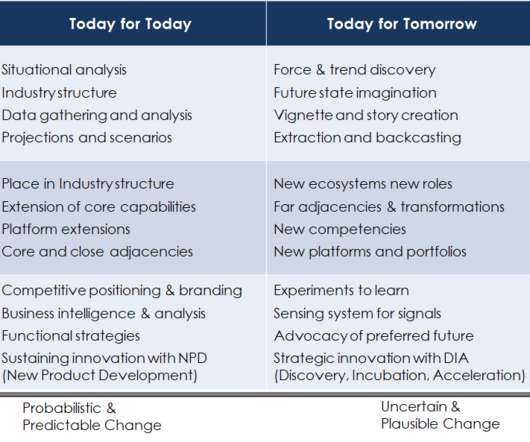You need a red team, not a red pill
Jeffrey Phillips
MAY 24, 2022
Red teams and blue teams originate from the military, where one team takes on the role of an attacker or proposes a strategy and another team seeks to disrupt or destroy the strategy.
This site uses cookies to improve your experience. To help us insure we adhere to various privacy regulations, please select your country/region of residence. If you do not select a country, we will assume you are from the United States. Select your Cookie Settings or view our Privacy Policy and Terms of Use.
Cookies and similar technologies are used on this website for proper function of the website, for tracking performance analytics and for marketing purposes. We and some of our third-party providers may use cookie data for various purposes. Please review the cookie settings below and choose your preference.
Used for the proper function of the website
Used for monitoring website traffic and interactions
Cookies and similar technologies are used on this website for proper function of the website, for tracking performance analytics and for marketing purposes. We and some of our third-party providers may use cookie data for various purposes. Please review the cookie settings below and choose your preference.

Jeffrey Phillips
MAY 24, 2022
Red teams and blue teams originate from the military, where one team takes on the role of an attacker or proposes a strategy and another team seeks to disrupt or destroy the strategy.

Strategos
MARCH 24, 2017
We are drawn to stories of entrepreneurs who came up with brilliant ideas that disrupted the existing “rules of the game” by which industry players compete with one another. Disruption. A recent report by the Economist showed that 60% of company executives view disruption as a threat rather than an opportunity.
This site is protected by reCAPTCHA and the Google Privacy Policy and Terms of Service apply.
From Rigid To Resilient: Why Enterprises Need Modular Commerce Now
How to Achieve High-Accuracy Results When Using LLMs
Relevance, Reach, Revenue: How to Turn Marketing Trends From Hype to High-Impact

Planview
AUGUST 29, 2017
Now, it promises to bring further disruption and fundamentally alter the way businesses grow, manage their finances and most importantly, meet the needs of their customers. billion in 2011 to $20.3 The union of finance and technology has already caused disruption across markets and industries, and that trend is unlikely to go away.

Business and Tech
DECEMBER 16, 2021
At the time we were looking to raise capital (between 2011 and 2013), businesses with women on the executive team received only 7 percent of the venture funding. Since the advancement of technology never stands still, we had to tackle developing major capabilities in a disruptive way while the proverbial clock was ticking.

Paul Hobcraft
JULY 25, 2016
McKinsey in 2011 identified that 72% of transformation programs fail to deliver on their targets so there is an awful lot of thinking, planning and working through any transformation to make sure you end up with the 28% of the success stories. We need to ask can this lead to disruption, ours and others for competitive advantage?

Paul Hobcraft
MAY 7, 2017
I often write and contribute to many other innovation businesses in different media channels specifically for innovation thought leadership where all my activity has been consistently voted in the top innovation knowledge providers since 2011, something I am incredibly proud to have achieved. Guide4innovating.

Mills-Scofield
OCTOBER 4, 2015
I am honored to host Whitney Johnson's post as part of the launch of her new book, Disrupt Yourself: Putting the Power of Disruptive Innovation to Work. ~~~~~~~~~~~~~~~~~~~~~~~~~~~~~~~~~~~~~~~~~~~~~~~~~~~~~~~~~~~~~~~~~~~~~~~~~~~~~~~~~~~~. As of 2011, only 26% of teens were employed. Which meant she needed to earn nearly $3,000.

Moves the Needle
AUGUST 14, 2018
The idea was conceived by Eric Ries and brought to life in his book The Lean Startup back in 2011. Others are being disrupted. Competition is now global. And it’s a good thing, since their current business model is facing massive disruption. Again, agility is not just for products.

Paul Hobcraft
JULY 25, 2016
McKinsey in 2011 identified that 72% of transformation programs fail to deliver on their targets so there is an awful lot of thinking, planning and working through any transformation to make sure you end up with the 28% of the success stories. We need to ask can this lead to disruption, ours and others for competitive advantage?

Paul Hobcraft
AUGUST 20, 2015
Then it becomes a mad scramble to transform ourselves, often with damaging consequences of deteriorating performance, battling more competition that are sensing our weakness, never capable of returning to those previous highs. Both require thinking that is broad and expansive, with a strong sense of curiosity and discovery.

Harvard Business Review
DECEMBER 20, 2011
From relentless demand for resources to bamboo-like 9% growth to vicious competition for the technologies and industries of the future, China will be the big story for a long time. These drivers underpin a number of stories from 2011, but a few new themes came out as well. Was a year like 2011 likely ? China, China, and China.

The Inovo Group
MAY 14, 2020
What is needed is a new strategic framework that serves both the current, increasingly competitive, situation as well as providing a strategic path through an uncertain future. By 2011, they had several established stores in the Washington DC area and were ready to expand. In 2011, customers were saying “Wow.

Qmarkets
JULY 5, 2017
In 2011, Swiss Post implemented Qmarkets’ full configurable enterprise-grade Q-max innovation software to allow staff from different departments and locations to share new business ideas in an organized, structured environment. This, we believed, would provide us with the competitive edge we were seeking. “We

Open Innovation EU
MAY 17, 2017
As opposed to entrepreneurship, entrepreneurial thinking is not necessarily bound to entrepreneurs (to be); it is an essential skill for ‘strengthening human capital, employability and competitiveness’ (Bacigalupo et al., Klein & Bullock, 2006; Lewin, 2011; Von Mises, 1949). Koppl, 2008; Lewin, 2011). Neck et al.

Innovation Excellence
MAY 18, 2020
So training tellers to process transactions efficiently was a key competitive trait. What’s more, these aren’t considered competitive traits, but commodity services. Clearly, by automating the book buying process, Amazon disrupted superstore book retailers like Barnes & Noble and Borders. Consider the case of bookstores.

Anaqua
MARCH 30, 2018
Those that are creative in utilizing existing data, combining internal and external data analytics, and innovate in ways to improve aligning R&D and IP with business objectives, will find opportunities for competitive advantage. End of 2011 $1,578. End of 2011 $48 (net of accumulated amortization of $1,114). billion ($2.9

Qmarkets
JULY 8, 2017
Put simply, Operational Excellence can be defined as a management principle which encourages the discovery and implementation of incremental changes, with the objective of optimizing processes to achieve a competitive advantage. In his 2011 book, Design for Operational Excellence, Kevin J. Right Idea, Wrong Approach.

New Markets Advisors
MAY 17, 2018
With the insights I’ve since gained at New Markets, I’d like to examine the University of Central Asia (UCA) through the lens of disruptive innovation and Jobs to Be Done, two concepts popularized by Clayton Christensen, the author of The Innovator’s Dilemma. The current university system is being disrupted, and this is only the beginning.

Qmarkets
OCTOBER 30, 2018
Especially when you consider that it is predicted that digital disruption is estimated to wipe out 40% of Fortune 500 firms in the next decade. Case in point, the Texas-based marketing firm Epsilon – which managed email communications for over 2,500 clients – suffered a breach in 2011 , resulting in 50 client databases being stolen.

Qmarkets
APRIL 24, 2017
Put simply, Operational Excellence can be defined as a management principle which encourages the discovery and implementation of incremental changes, with the objective of optimizing processes to achieve a competitive advantage. In his 2011 book, Design for Operational Excellence, Kevin J. Right Idea, Wrong Approach.

Qmarkets
JULY 8, 2017
In 2011, Swiss Post implemented Qmarkets’ full configurable enterprise-grade Q-max innovation software to allow staff from different departments and locations to share new business ideas in an organized, structured environment. This, we believed, would provide us with the competitive edge we were seeking. “We

Harvard Business Review
DECEMBER 20, 2011
The two biggest product stories of 2011 were arguably Lipitor and the iPhone 4S. With Lipitor's annual global sales still approaching $10 billion and new generic competition poised to significantly eat away its sales, managing the end of its life cycle is critical for Pfizer's near-term outlook. 30) of a blockbuster prescription drug.

hackerearth
OCTOBER 16, 2017
Innovation management initiatives focus on disruptive or step changes that transform the business in some significant way. For instance, an emerging business is likely to be focusing on one main product, unlike a mature organization that is looking to fortify its position in the market or find new, disruptive innovations.

hackerearth
OCTOBER 16, 2017
Innovation management initiatives focus on disruptive or step changes that transform the business in some significant way. For instance, an emerging business is likely to be focusing on one main product, unlike a mature organization that is looking to fortify its position in the market or find new, disruptive innovations.

Qmarkets
APRIL 24, 2017
GroupMe, a group messaging app, began as a hackathon project at the TechCrunch Disrupt conference in 2010. In 2011 it was acquired for $85 million by Skype. Some major companies were in fact born from these hackathons. Likewise the software company Nitobi began as a project at the iPhoneDevCamp in 2008. Create Community.

Harvard Business Review
AUGUST 20, 2012
Embrace Industry Disruption. Consider the transformation at Forbes , the business publishing and media company, which has embraced the shift from traditional print media to online publishing, salvaging a business that was being disrupted, and becoming a disrupter itself.

Harvard Business Review
SEPTEMBER 18, 2012
A McKinsey study released in May 2011 stated that, by using Big Data to the fullest, retailers stood to increase their operating margins by up to 60% — this, in an industry where net profit margins are often less than 2%. Retail has entered the era of Big Data.

Harvard Business Review
JUNE 10, 2014
Almost every discussion of innovation today inevitably turns to the topic of “disruption.” Academics write about the power of disruptive innovation to transform one industry after another. Consultants have set up practices to focus specifically on helping companies become disruptive innovators. But was the device disruptive?

Qmarkets
JULY 8, 2017
GroupMe, a group messaging app, began as a hackathon project at the TechCrunch Disrupt conference in 2010. In 2011 it was acquired for $85 million by Skype. Some major companies were in fact born from these hackathons. Likewise the software company Nitobi began as a project at the iPhoneDevCamp in 2008. Create Community.

Harvard Business Review
DECEMBER 12, 2011
I was also partially accurate in predicting that Google would "strike back" in 2011. It's likely that the trend will have to evolve given how competition for our time and attention this gaming creates. Ideas, opinions, media, status updates are all part of what makes social media a powerful and often disruptive force.

Harvard Business Review
MAY 10, 2013
As noted management expert Geoffrey Moore told me with respect to high-velocity competition, "I''m not sure you ever want to be in the public markets." The pressure on the company by the investing community (among others) was so severe that it eventually split into two, Motorola Mobility and Motorola Solutions in January of 2011.

Harvard Business Review
NOVEMBER 8, 2013
To meet these challenges, we believe academic medicine must embrace disruptive innovation in its core missions: educating the next generation of health professionals, offering comprehensive cutting-edge patient care, and leading biomedical and clinical research. Disruptive technologies threaten every mission of the academic health center.

Harvard Business Review
MARCH 22, 2013
The center of gravity for jobs, wealth, and market opportunities is moving, disrupting the world economic order as we have known it. In 2011, for the third year in a row, the Euromonitor International market research firm ranked Haier as the top appliance brand in the world, calculated its retail volume share as 7.8

Harvard Business Review
MARCH 12, 2012
By some estimates, China has supported its domestic solar industry with $34 billion in loans; that cash, an ability to rapidly ape western technologies , and the competitive advantages of low-cost labor and limited regulatory restraints allowed Chinese companies to sweep away Western competitor after Western competitor in 2011.

Harvard Business Review
MARCH 23, 2011
For a number of reasons, the size, complexity scale and symmetry of risk are vastly different in 2011 than 1991. Every half century or so, the risk assumptions underlying our economic, social and political foundations change dramatically.

Harvard Business Review
MAY 25, 2015
As of 2011, only 26% of teens were employed. Certainly the reasons for this decline are multifaceted, from a struggling economy, to competition with older workers, to time conflicts, to the fact that many teens just don’t want traditional “teen jobs.” And don’t forget the competitive college admissions market.

Harvard Business Review
MAY 20, 2014
The rate of business formation in 2011 was almost half of what it was in 1978, with the rate of dissolution somewhat higher than the past couple decades. Deep, disruptive economic change is all around us, but the data indicates that the national response has not been, contrary to our myths and history, one of increased entrepreneurship.

Harvard Business Review
DECEMBER 14, 2018
Writing in the Sloan Management Review, Boston College professor Gerald Kane noted that 87% of executives surveyed indicated that digital technologies will disrupt their industries to a great or moderate extent. Yet fewer than half felt that their companies were doing enough to address this disruption.

Harvard Business Review
AUGUST 7, 2013
"Free" product competition strikes again and the latest casualty is Weight Watchers, whose CEO recently left the company in the midst of the onslaught of free weight loss and fitness applications. Competition Disruptive innovation' Think about a classic case. The story is the same with Weight Watchers. Of course not.

Harvard Business Review
JUNE 26, 2013
Regulators — often spurred into action by incumbents threatened by the new competition — have cast jaundiced looks in the direction of every one of the new sharing economy services, in some cases ruling them in violation of long-standing laws. Disruptive innovation Government Internet' These are not rhetorical questions.

Harvard Business Review
JULY 27, 2016
Changing this antiquated approach to defining quality starts with cooperation in the market, not competition. The solution is to foster competition among care providers that’s based on their track record in adhering to the quality standards. Special interests impose a continued obstacle to change.

Harvard Business Review
FEBRUARY 8, 2012
It's deciding to stop talking about the competitive threat, and instead asking what it will take to leapfrog those competitors. Instead, we need to embrace fearlessness, turning people loose to create strategies, disruptive innovations, and next-gen business models. Will Yahoo turn this around? Can't tell yet.

Harvard Business Review
NOVEMBER 20, 2015
Since 2011, as emerging markets have suffered from slower growth and fresh social unrest, that $30 trillion prize seems more distant. Second, with the public declarations by many companies to help with the goals , there is likely to be competitive pressure. of the time.

Harvard Business Review
SEPTEMBER 24, 2013
Led by its Steve Jobs-inspired CEO Lei Jun, the company has experienced breakneck speed since its first smartphone launch in October 2011. But, in Clay Christensen’s disruption language , this approach puts them on a “sustaining” rather than “disruptive” path. Disruptive innovation Global business'
Expert insights. Personalized for you.
Are you sure you want to cancel your subscriptions?


Let's personalize your content